1960 Alfa Romeo Giulietta Spider embodies the spirit of Italian automotive artistry, a captivating blend of sleek design and exhilarating performance that defined a golden era in sports car history. This iconic roadster, born in the heart of postwar Italy, captured the imagination of enthusiasts worldwide, becoming a symbol of style and sophistication.
The Giulietta Spider emerged as a masterpiece of engineering and design, showcasing Alfa Romeo’s unwavering commitment to creating vehicles that were both beautiful and capable. It seamlessly integrated the brand’s racing heritage with the elegance of Italian craftsmanship, offering a driving experience that was both exhilarating and refined.
The Giulietta Spider’s influence on the automotive world is undeniable, leaving a lasting legacy that continues to inspire car enthusiasts today.
Historical Context
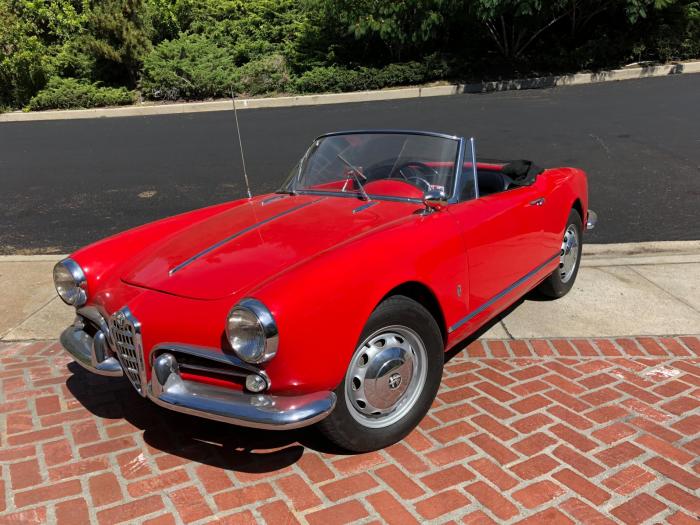
The 1960s were a pivotal decade for the automotive industry, marked by a surge in demand for personal vehicles and a shift towards more stylish and sporty designs. This period witnessed the rise of iconic models that continue to capture the imagination of enthusiasts today.Alfa Romeo, a renowned Italian automaker with a rich racing heritage, played a significant role in shaping the automotive landscape of the 1960s.
Known for its performance-oriented vehicles and elegant styling, Alfa Romeo was synonymous with Italian design and engineering excellence.
The Giulietta’s Origins and Place in Alfa Romeo’s Model Lineup
The Giulietta, introduced in 1954, was a groundbreaking model for Alfa Romeo. It was the first car to feature the brand’s innovative “unibody” construction, which combined the chassis and body into a single unit, resulting in a lighter and more rigid structure.
The Giulietta’s success paved the way for a series of popular models, including the Giulietta Spider, which was launched in 1959. The Giulietta Spider was a two-seater roadster that captured the spirit of the era, combining performance and elegance. It was powered by a 1.3-liter four-cylinder engine, which produced 80 horsepower.
The Giulietta Spider was praised for its handling, its responsive engine, and its stylish design.
Design and Styling
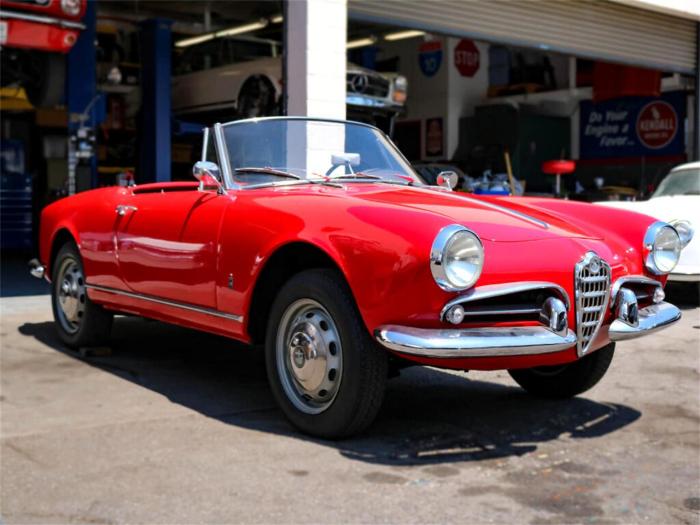
The Alfa Romeo Giulietta Spider, designed by Pininfarina, was a striking example of Italian automotive design in the late 1950s and early 1960s. Its elegant lines and graceful proportions captivated enthusiasts worldwide.
Exterior Design
The Giulietta Spider’s exterior design was characterized by its flowing curves and sporty stance. The long hood, low-slung profile, and sculpted fenders gave the car a dynamic and athletic appearance. The front end featured a distinctive grille with a prominent Alfa Romeo badge and rounded headlights.
The rear end was equally stylish, with a wraparound rear window, integrated taillights, and a graceful, sloping roofline.
Comparison to Contemporary Sports Cars
The Giulietta Spider’s styling was considered ahead of its time, even compared to other contemporary sports cars. While some rivals, like the British MG MGA, opted for more traditional designs, the Giulietta Spider’s sleek and modern aesthetic set it apart.
The 1960 Alfa Romeo Giulietta Spider, a true Italian icon, offered a blend of style and performance that captured the hearts of enthusiasts. While the standard Giulietta Spider was already a head-turner, the 1960 Alfa Romeo Giulietta Spider Veloce took things to another level.
This sportier version boasted a more powerful engine and a host of performance upgrades, making it a true driving machine. The Giulietta Spider, in all its variations, continues to be a sought-after classic, representing the golden age of Italian automotive design.
The car’s distinctive features, such as its low-profile windshield and integrated bumpers, emphasized its sporty character and contributed to its enduring appeal.
Interior Design
The interior of the Giulietta Spider was equally well-appointed, offering a blend of comfort and sportiness. The dashboard featured a simple yet elegant layout with a large speedometer and tachometer, along with smaller gauges for fuel, oil pressure, and temperature.
The seats were upholstered in high-quality leather, and the overall feel of the interior was one of refined craftsmanship.
Engine and Performance
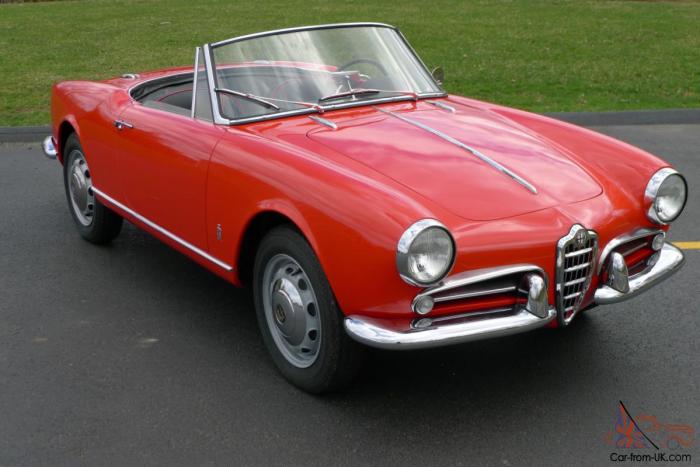
The Alfa Romeo Giulietta Spider, while known for its elegant design, also offered respectable performance for its time. Its engine, a hallmark of Alfa Romeo’s engineering, was a key contributor to the car’s spirited driving experience.
Engine Specifications and Power Output
The Giulietta Spider was powered by a 1.3-liter four-cylinder engine, a refined version of the unit found in the Giulia sedan. This engine produced a modest 65 horsepower, which, while not groundbreaking, was adequate for the car’s lightweight construction. The engine was paired with a four-speed manual transmission, allowing drivers to fully engage with the car’s performance.
Driving Experience and Performance Characteristics
The Giulietta Spider’s driving experience was characterized by its agility and responsiveness. The car’s light weight and relatively small engine allowed it to accelerate briskly, with a top speed of around 90 mph. The handling was praised for its precision and feedback, making it enjoyable to drive on winding roads.
The 1960 Alfa Romeo Giulietta Spider, a classic Italian roadster, is renowned for its elegant design and spirited performance. Sharing the same lineage as the iconic 1960 Alfa Romeo Giulietta T.I. , the Spider boasted a lightweight chassis and a powerful engine that made it a joy to drive.
While the T.I. was a more focused touring car, the Spider offered an open-air experience, captivating drivers with its timeless appeal.
The steering, though not power-assisted, was direct and communicative, giving drivers a sense of connection to the road.
Performance Comparison to Other Cars in Its Class
The Giulietta Spider competed with other small sports cars of its era, such as the Triumph TR3 and the MG MGA. While the Giulietta Spider’s power output was modest compared to some of its rivals, its agile handling and engaging driving experience made it a strong contender.
Its lightweight construction and well-balanced chassis allowed it to hold its own on winding roads, offering a driving experience that was both enjoyable and rewarding.
Production and Significance
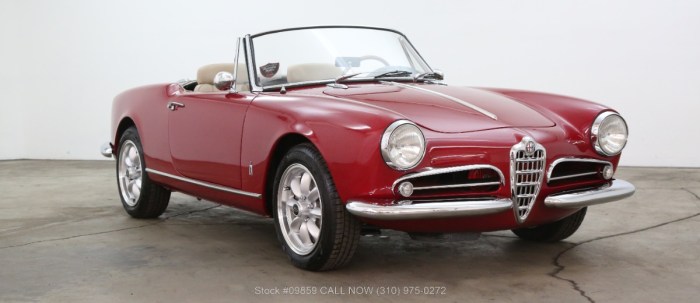
The Alfa Romeo Giulietta Spider, a true icon of Italian automotive design, enjoyed a successful production run that spanned over a decade, establishing its place in automotive history and captivating enthusiasts worldwide. Its production and impact extended beyond mere numbers, shaping the landscape of sports cars and influencing generations of drivers.
The 1960 Alfa Romeo Giulietta Spider, with its elegant lines and spirited performance, was a true icon of Italian design. This classic roadster paved the way for a legacy of captivating sports cars, culminating in the 1991 Alfa Romeo Spider.
The 1991 model, while a more modern iteration, still retained the essence of the Giulietta Spider’s charm, offering a thrilling driving experience with its sleek profile and powerful engine. Both cars, in their own right, represent the spirit of Alfa Romeo: a blend of Italian style and exhilarating performance.
Production Run
The Giulietta Spider’s production began in 1959, continuing until 1965, with several variations and special editions emerging throughout its lifespan. The car was initially produced by Carrozzeria Zagato, a renowned Italian coachbuilder, and later by Bertone, another prominent design house.
The 1960 Alfa Romeo Giulietta Spider, with its elegant lines and powerful engine, was a true icon of Italian automotive design. While the 1960 model was a masterpiece in its own right, the following year saw a refined iteration with the 1961 Alfa Romeo Giulietta Spider , which featured subtle but impactful updates to the exterior and interior.
Both models remain highly sought-after today, representing the pinnacle of classic Italian sports car craftsmanship.
The following table details the production run of the Giulietta Spider:
| Model Year | Production Numbers |
|---|---|
| 1960 | 1,020 |
| 1961 | 1,275 |
| 1962 | 1,300 |
| 1963 | 1,000 |
| 1964 | 1,100 |
| 1965 | 1,000 |
The total production of the Giulietta Spider across all model years amounted to approximately 6,700 units, making it a relatively rare and sought-after classic car today.
Notable Variations and Special Editions
Several notable variations and special editions of the Giulietta Spider were produced, adding to its allure and appeal to collectors.
- Giulietta Spider Veloce: Introduced in 1961, the Veloce featured a more powerful engine and enhanced performance, making it a true sports car.
- Giulietta Spider 1600: This model, launched in 1964, featured a larger 1.6-liter engine, offering improved power and torque.
- Giulietta Spider “Coda Tronca”: This limited-edition version, produced in 1962, featured a distinctive truncated tail, a design element that was both aesthetically striking and aerodynamically efficient. Only 250 examples of this rare variant were produced, making it highly collectible today.
Cultural Impact and Legacy
The Giulietta Spider’s impact extended far beyond its production numbers, solidifying its place as a cultural icon and a symbol of Italian style and engineering. The Giulietta Spider was featured in numerous films and television shows, further boosting its popularity and associating it with glamour and sophistication.
The 1960 Alfa Romeo Giulietta Spider, a classic Italian sports car, was a symbol of elegance and performance. Its sleek design and powerful engine made it a popular choice for enthusiasts. While the Giulietta Spider is considered a timeless masterpiece, its later successor, the 1987 Alfa Romeo 2000 Spider Veloce , continued the legacy of Italian craftsmanship.
The Veloce, with its more modern features and improved handling, became a sought-after model in its own right. However, the Giulietta Spider remains an iconic representation of the golden age of Italian automotive design.
“The Giulietta Spider is a car that embodies the spirit of Italian design. It’s beautiful, it’s stylish, and it’s fun to drive. It’s a car that has captured the hearts of enthusiasts for generations.”
A well-known automotive journalist
The Giulietta Spider’s legacy lives on today, with its design inspiring countless other sports cars and its performance captivating drivers worldwide. It remains a coveted classic car, sought after by collectors and enthusiasts alike.
Collecting and Restoration
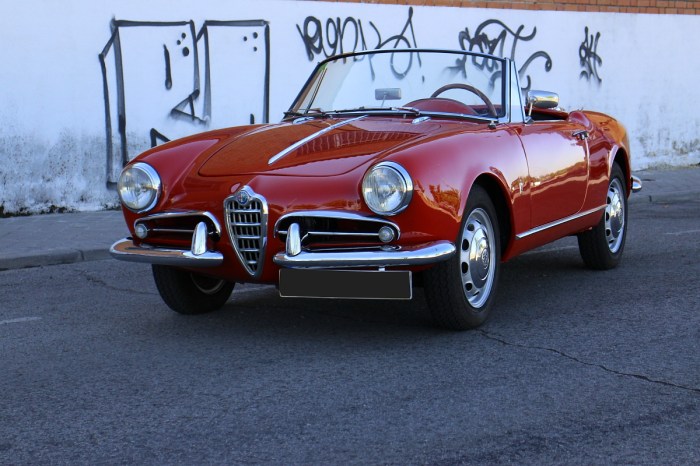
The 1960 Alfa Romeo Giulietta Spider is a highly sought-after classic car, making it a desirable addition to any collector’s garage. Its timeless design, captivating performance, and rich history continue to attract enthusiasts and investors alike. However, acquiring and restoring a Giulietta Spider requires a significant investment of time, effort, and resources.
The Collector Market for the 1960 Giulietta Spider, 1960 Alfa Romeo Giulietta Spider
The collector market for the 1960 Giulietta Spider is robust and competitive. Prices vary depending on the car’s condition, originality, and provenance. Well-preserved, original examples can fetch upwards of $100,000, while restored cars command prices in the $75,000 to $150,000 range.
The market is generally strong, with prices steadily increasing over the past few years. This growth is attributed to the car’s enduring popularity, its increasing scarcity, and the growing interest in classic Italian sports cars.
Challenges and Rewards of Restoring a Giulietta Spider
Restoring a 1960 Giulietta Spider is a challenging but rewarding undertaking. The car’s age and the complexity of its mechanical systems can present significant obstacles. Finding original parts can be difficult and expensive, and sourcing high-quality replacements requires careful research and sourcing.
However, the satisfaction of restoring a Giulietta Spider to its former glory is immense. The process allows owners to connect with the car’s history, learn about its intricate mechanics, and create a truly unique and personal piece of automotive art.
Identifying Original Features and Avoiding Common Restoration Pitfalls
One of the key challenges in restoring a Giulietta Spider is ensuring that the car remains authentic. Many cars have been modified or restored using non-original parts over the years, so it’s essential to be able to identify original features and avoid common restoration pitfalls.
Here are some tips:
- Research and Documentation:Thoroughly research the car’s history and consult original documentation, such as the owner’s manual, parts catalog, and factory service bulletins. This will provide valuable insights into the car’s original specifications and help you identify any modifications or inconsistencies.
- Expert Consultation:Consult with experienced Alfa Romeo specialists or restoration experts to obtain their opinions on the car’s authenticity and to identify any potential issues. They can also provide guidance on sourcing original parts and avoiding common restoration mistakes.
- Original Parts Identification:Learn to identify original parts by their markings, materials, and construction methods. Many parts, such as the engine, transmission, and suspension components, have unique markings or casting numbers that can help confirm their authenticity. Original parts are generally of higher quality and will ensure that the car retains its original character.
- Avoid Common Pitfalls:Be wary of aftermarket parts that may not be compatible or meet the original specifications. Also, be cautious of restoration work that is not done to the highest standards, as this can devalue the car. A poorly executed restoration can be more difficult to undo than a well-maintained original car.
Visual Representation: 1960 Alfa Romeo Giulietta Spider
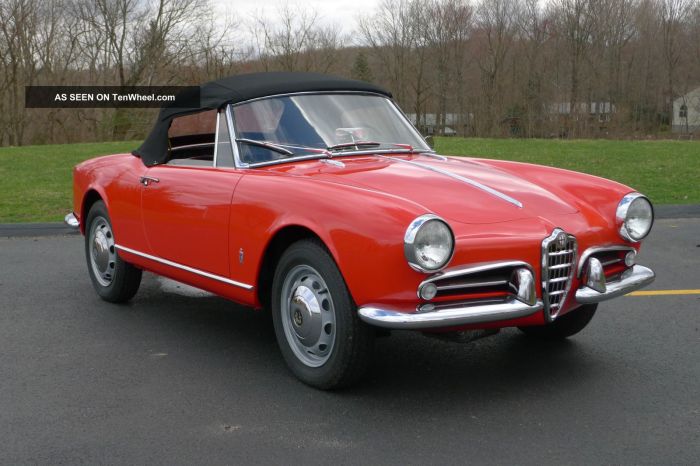
The Giulietta Spider’s enduring appeal lies not only in its performance but also in its timeless design. This section delves into the visual aspects of the car, exploring its exterior and interior design elements through images and descriptions. Additionally, a visual timeline highlights key milestones in the Giulietta Spider’s history.
Exterior Design Elements
The Giulietta Spider’s exterior design is a harmonious blend of elegance and sportiness. Its sleek lines, flowing curves, and distinctive features create a captivating visual presence.
| Feature | Image | Description |
|---|---|---|
| Front Grille | [Image of the front grille with the Alfa Romeo logo] | The signature Alfa Romeo shield grille, with its vertical chrome bars, dominates the front fascia. The grille seamlessly integrates with the headlights, creating a visually cohesive and striking front end. |
| Headlights | [Image of the headlights] | The twin round headlights, with their distinctive chrome bezels, are a defining characteristic of the Giulietta Spider. They project a classic and elegant look while providing excellent illumination. |
| Body Lines | [Image of the car’s profile showcasing the body lines] | The Giulietta Spider’s body lines flow gracefully from the front to the rear, creating a sense of motion even when stationary. The long hood, sloping roofline, and sculpted flanks contribute to the car’s aerodynamic profile. |
| Tail Lights | [Image of the tail lights] | The rear tail lights, with their distinctive circular shape and red lenses, provide a clear and visible signal to other drivers. They also contribute to the car’s sporty and stylish rear end. |
| Wheels | [Image of the wheels] | The Giulietta Spider was available with various wheel designs, including wire wheels and alloy wheels. The wheels are typically painted in a contrasting color to the body, enhancing the car’s visual appeal. |
Interior Design Elements
The Giulietta Spider’s interior is a testament to Italian craftsmanship, with a focus on quality materials and a driver-centric layout.
| Feature | Image | Description |
|---|---|---|
| Dashboard | [Image of the dashboard] | The dashboard is characterized by its simple yet functional design. It features a large speedometer and tachometer, along with smaller gauges for fuel level, oil pressure, and water temperature. |
| Steering Wheel | [Image of the steering wheel] | The steering wheel, typically a three-spoke design, provides a comfortable and responsive grip. It features a classic horn button and is often finished in leather. |
| Seats | [Image of the seats] | The seats are typically upholstered in leather or fabric and offer a comfortable and supportive ride. The front seats are often designed with a sporty, bucket-style shape. |
| Interior Trim | [Image of the interior trim] | The Giulietta Spider’s interior is often adorned with wood trim or other decorative elements, adding a touch of elegance and refinement to the cabin. |
Visual Timeline
The Giulietta Spider’s history is marked by several key milestones that shaped its evolution.
- 1955:The Alfa Romeo Giulietta Sprint is introduced, setting the stage for the Giulietta Spider. The Sprint’s sleek design and performance would inspire the Spider’s development.
- 1959:The Alfa Romeo Giulietta Spider is unveiled at the Turin Motor Show. The car’s elegant lines, powerful engine, and open-top design quickly capture the attention of enthusiasts.
- 1961:The Giulietta Spider Veloce is introduced, featuring a more powerful engine and improved performance.
- 1962:The Giulietta Spider is updated with a new grille and taillights.
- 1965:The Giulietta Spider is discontinued, marking the end of an era. The car’s legacy, however, continues to inspire automotive enthusiasts around the world.
Last Word
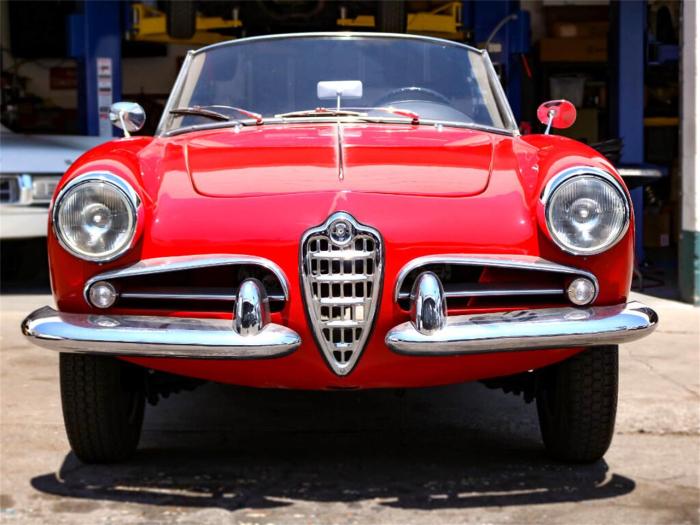
The 1960 Alfa Romeo Giulietta Spider stands as a testament to the enduring power of Italian design and engineering. Its legacy extends far beyond its original production run, inspiring generations of car enthusiasts and serving as a timeless symbol of automotive excellence.
Whether admired for its sleek lines, its exhilarating performance, or its captivating history, the Giulietta Spider continues to captivate and enthrall, reminding us of the enduring allure of classic Italian sports cars.